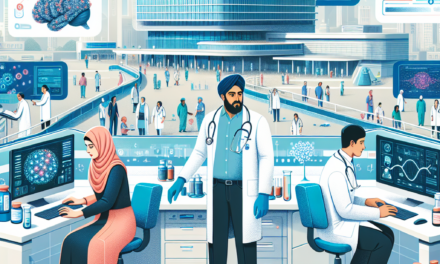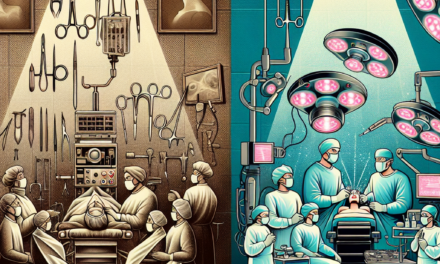Shaping Interoperability: Balancing Patient Experience and AI Needs

In the rapidly evolving landscape of healthcare, the integration of artificial intelligence (AI) and the enhancement of patient experience are two pivotal elements driving change. As healthcare systems strive to become more efficient and patient-centered, the concept of interoperability has emerged as a critical factor. Interoperability refers to the ability of different information systems, devices, and applications to access, exchange, integrate, and cooperatively use data in a coordinated manner. This article delves into the intricate balance between improving patient experience and meeting the needs of AI through effective interoperability.
The Importance of Interoperability in Healthcare
Interoperability in healthcare is not just a technical requirement; it is a fundamental enabler of improved patient outcomes and operational efficiency. The seamless exchange of information across different healthcare systems can significantly enhance the quality of care provided to patients. This section explores the importance of interoperability in healthcare, highlighting its impact on patient experience and AI integration.
Enhancing Patient Experience through Seamless Data Exchange
One of the primary benefits of interoperability is the enhancement of patient experience. When healthcare providers can access comprehensive patient data from various sources, they can deliver more personalized and timely care. This seamless data exchange reduces the need for repetitive tests and procedures, minimizing patient discomfort and inconvenience.
For instance, consider a patient with a chronic condition who visits multiple specialists. With interoperable systems, each specialist can access the patient’s complete medical history, ensuring that treatment plans are coordinated and consistent. This not only improves the quality of care but also enhances the patient’s overall experience by reducing the burden of managing their own health information.
Moreover, interoperability facilitates better communication between patients and healthcare providers. Patients can access their health records, test results, and treatment plans through patient portals, empowering them to take an active role in their healthcare journey. This transparency fosters trust and engagement, leading to improved patient satisfaction.
Supporting AI-Driven Innovations in Healthcare
Interoperability is a cornerstone for the successful integration of AI technologies in healthcare. AI systems rely on vast amounts of data to train algorithms and make accurate predictions. Without interoperable systems, accessing and aggregating this data becomes a significant challenge.
AI applications in healthcare, such as predictive analytics, diagnostic tools, and personalized treatment recommendations, require access to diverse datasets from various sources. Interoperability ensures that these datasets can be seamlessly integrated, enabling AI systems to deliver more accurate and reliable insights.
For example, AI-driven diagnostic tools can analyze medical images from different imaging systems to detect anomalies with high precision. This capability is only possible when these systems can communicate and share data effectively. By facilitating data exchange, interoperability empowers AI to enhance diagnostic accuracy and improve patient outcomes.
Challenges in Achieving Interoperability
Despite its numerous benefits, achieving interoperability in healthcare is not without challenges. One of the primary obstacles is the lack of standardized data formats and protocols. Healthcare systems often use proprietary formats, making it difficult to exchange information seamlessly.
Additionally, data privacy and security concerns pose significant challenges to interoperability. Healthcare organizations must ensure that patient data is protected during transmission and storage. Balancing the need for data sharing with stringent privacy regulations requires careful planning and implementation.
Another challenge is the resistance to change within healthcare organizations. Implementing interoperable systems often requires significant investments in technology and training. Overcoming these barriers requires a cultural shift towards embracing digital transformation and recognizing the long-term benefits of interoperability.
Case Studies: Successful Interoperability Initiatives
Several healthcare organizations have successfully implemented interoperability initiatives, demonstrating the potential benefits of seamless data exchange. One notable example is the Veterans Health Administration (VHA) in the United States. The VHA has developed an interoperable electronic health record (EHR) system that allows healthcare providers to access patient information across different facilities.
This initiative has improved care coordination for veterans, reducing duplication of tests and enhancing the quality of care. By enabling healthcare providers to access comprehensive patient data, the VHA has enhanced patient experience and improved health outcomes.
Another successful case study is the NHS Digital in the United Kingdom. NHS Digital has implemented the NHS Spine, a national infrastructure that supports interoperability across the healthcare system. The NHS Spine enables healthcare providers to access patient records, prescriptions, and test results, facilitating better care coordination and improving patient experience.
The Future of Interoperability in Healthcare
The future of interoperability in healthcare holds immense potential for transforming patient experience and AI integration. As technology continues to advance, healthcare systems will become more interconnected, enabling seamless data exchange and collaboration.
Emerging technologies such as blockchain and the Internet of Things (IoT) are expected to play a significant role in enhancing interoperability. Blockchain can provide a secure and transparent platform for data exchange, ensuring data integrity and privacy. IoT devices can collect real-time patient data, enabling continuous monitoring and personalized care.
Furthermore, the adoption of standardized data formats and protocols will facilitate interoperability across different healthcare systems. Initiatives such as the Fast Healthcare Interoperability Resources (FHIR) standard are gaining traction, providing a framework for exchanging healthcare information electronically.
Balancing Patient Experience and AI Needs
While interoperability offers numerous benefits, achieving a balance between enhancing patient experience and meeting AI needs requires careful consideration. This section explores the challenges and strategies for balancing these two critical aspects of healthcare.
Understanding Patient-Centric Interoperability
Patient-centric interoperability focuses on improving the patient experience by ensuring that healthcare systems are designed with the patient’s needs in mind. This approach emphasizes transparency, accessibility, and empowerment, enabling patients to take an active role in their healthcare journey.
One key aspect of patient-centric interoperability is ensuring that patients have access to their health information. Patient portals and mobile applications allow patients to view their medical records, test results, and treatment plans, empowering them to make informed decisions about their health.
Moreover, patient-centric interoperability involves designing systems that are intuitive and user-friendly. Complex interfaces and technical jargon can be barriers to patient engagement. By prioritizing user experience, healthcare organizations can enhance patient satisfaction and foster trust.
Addressing AI’s Data Requirements
AI systems require vast amounts of data to function effectively. To meet AI needs, healthcare organizations must ensure that data is accessible, accurate, and comprehensive. This requires robust data governance frameworks and standardized data formats.
Data quality is a critical factor in AI-driven healthcare applications. Inaccurate or incomplete data can lead to erroneous predictions and recommendations, compromising patient safety. Healthcare organizations must implement data validation processes to ensure data integrity and reliability.
Furthermore, healthcare organizations must address data silos that hinder AI integration. Data silos occur when information is stored in isolated systems, preventing seamless data exchange. By breaking down these silos and promoting data sharing, healthcare organizations can unlock the full potential of AI.
Ensuring Data Privacy and Security
Data privacy and security are paramount in healthcare, especially when dealing with sensitive patient information. Healthcare organizations must implement robust security measures to protect data during transmission and storage.
Encryption, access controls, and audit trails are essential components of a comprehensive data security strategy. These measures ensure that only authorized individuals can access patient data, reducing the risk of data breaches and unauthorized access.
Moreover, healthcare organizations must comply with data privacy regulations such as the Health Insurance Portability and Accountability Act (HIPAA) in the United States and the General Data Protection Regulation (GDPR) in the European Union. Compliance with these regulations ensures that patient data is handled responsibly and ethically.
Collaborative Approaches to Interoperability
Achieving interoperability requires collaboration among various stakeholders, including healthcare providers, technology vendors, policymakers, and patients. Collaborative approaches foster innovation and drive the development of interoperable solutions.
Healthcare organizations can collaborate with technology vendors to develop interoperable systems that meet the needs of both patients and AI. By working together, they can design solutions that prioritize user experience while ensuring data accessibility and integration.
Policymakers play a crucial role in promoting interoperability by establishing standards and regulations that facilitate data exchange. By providing clear guidelines and incentives, policymakers can encourage healthcare organizations to adopt interoperable systems.
Patients also have a role to play in shaping interoperability. By advocating for their rights to access and control their health information, patients can drive demand for patient-centric solutions that enhance their experience.
Case Studies: Balancing Patient Experience and AI Needs
Several healthcare organizations have successfully balanced patient experience and AI needs through innovative interoperability initiatives. One notable example is the Mayo Clinic in the United States. The Mayo Clinic has implemented an interoperable EHR system that integrates patient data from various sources, enabling personalized care and AI-driven insights.
This initiative has improved patient experience by providing patients with access to their health information through a user-friendly portal. Patients can view their medical records, schedule appointments, and communicate with healthcare providers, enhancing engagement and satisfaction.
Another successful case study is the Karolinska University Hospital in Sweden. The hospital has developed an AI-driven platform that analyzes patient data from different sources to provide personalized treatment recommendations. This platform leverages interoperable systems to access comprehensive patient data, ensuring accurate and reliable insights.
Technological Innovations Driving Interoperability
Technological innovations are at the forefront of driving interoperability in healthcare. This section explores the emerging technologies that are shaping the future of interoperability and their impact on patient experience and AI integration.
Blockchain Technology for Secure Data Exchange
Blockchain technology has the potential to revolutionize interoperability by providing a secure and transparent platform for data exchange. Blockchain’s decentralized nature ensures data integrity and privacy, making it an ideal solution for healthcare interoperability.
By using blockchain, healthcare organizations can create a tamper-proof record of patient data that can be accessed by authorized individuals. This ensures that data is accurate and reliable, reducing the risk of errors and fraud.
Moreover, blockchain can facilitate data sharing across different healthcare systems without compromising privacy. Patients can control access to their data, granting permissions to specific healthcare providers as needed. This empowers patients to take ownership of their health information while ensuring data security.
The Role of IoT in Enhancing Interoperability
The Internet of Things (IoT) is transforming healthcare by enabling real-time data collection and monitoring. IoT devices, such as wearable sensors and smart medical devices, can collect patient data continuously, providing valuable insights for personalized care.
Interoperability is crucial for integrating IoT devices into healthcare systems. By ensuring that IoT devices can communicate with EHR systems and other healthcare applications, healthcare organizations can leverage real-time data to improve patient outcomes.
For example, IoT devices can monitor patients with chronic conditions, alerting healthcare providers to any changes in their health status. This enables timely interventions and reduces the risk of complications, enhancing patient experience and improving health outcomes.
Artificial Intelligence and Machine Learning in Interoperability
Artificial intelligence and machine learning are driving innovations in interoperability by enabling advanced data analysis and decision-making. AI algorithms can analyze vast amounts of data from different sources, providing valuable insights for personalized care.
Interoperability is essential for AI systems to access diverse datasets and deliver accurate predictions and recommendations. By integrating AI with interoperable systems, healthcare organizations can enhance diagnostic accuracy, optimize treatment plans, and improve patient outcomes.
For instance, AI-driven diagnostic tools can analyze medical images from different imaging systems to detect anomalies with high precision. This capability is only possible when these systems can communicate and share data effectively.
Cloud Computing for Scalable Interoperability
Cloud computing is transforming healthcare by providing scalable and flexible solutions for data storage and exchange. Cloud-based platforms enable healthcare organizations to store and access patient data securely, facilitating interoperability across different systems.
By leveraging cloud computing, healthcare organizations can overcome the limitations of traditional on-premises systems. Cloud-based solutions offer scalability, allowing organizations to handle large volumes of data and accommodate growing demands for interoperability.
Moreover, cloud computing enables seamless data exchange between different healthcare systems, enhancing care coordination and improving patient experience. Healthcare providers can access patient data from anywhere, ensuring timely and accurate care delivery.
Case Studies: Technological Innovations in Interoperability
Several healthcare organizations have successfully implemented technological innovations to enhance interoperability. One notable example is the Cleveland Clinic in the United States. The Cleveland Clinic has adopted a cloud-based EHR system that enables seamless data exchange across different facilities.
This initiative has improved care coordination and enhanced patient experience by providing healthcare providers with access to comprehensive patient data. Patients can also access their health information through a user-friendly portal, empowering them to take an active role in their healthcare journey.
Another successful case study is the Singapore General Hospital. The hospital has implemented an IoT-driven platform that monitors patients’ vital signs in real-time. This platform leverages interoperable systems to integrate data from IoT devices with EHR systems, enabling personalized care and timely interventions.
Regulatory and Policy Considerations
Regulatory and policy considerations play a crucial role in shaping interoperability in healthcare. This section explores the regulatory landscape and its impact on patient experience and AI integration.
Data Privacy Regulations and Interoperability
Data privacy regulations are essential for ensuring that patient data is handled responsibly and ethically. Regulations such as HIPAA in the United States and GDPR in the European Union establish guidelines for data protection and privacy.
Compliance with these regulations is crucial for achieving interoperability while safeguarding patient privacy. Healthcare organizations must implement robust security measures to protect data during transmission and storage.
Moreover, data privacy regulations empower patients to control access to their health information. Patients have the right to access their data, request corrections, and grant permissions to specific healthcare providers. This transparency fosters trust and engagement, enhancing patient experience.
Standardization Initiatives for Interoperability
Standardization initiatives are essential for achieving interoperability across different healthcare systems. Standards such as FHIR provide a framework for exchanging healthcare information electronically.
By adopting standardized data formats and protocols, healthcare organizations can facilitate seamless data exchange and integration. Standardization ensures that data is consistent and compatible, reducing the risk of errors and improving data quality.
Moreover, standardization initiatives promote collaboration among healthcare providers, technology vendors, and policymakers. By working together, stakeholders can develop interoperable solutions that meet the needs of both patients and AI.
Incentives for Interoperability Adoption
Incentives play a crucial role in encouraging healthcare organizations to adopt interoperable systems. Policymakers can provide financial incentives, such as grants and reimbursements, to support interoperability initiatives.
Moreover, policymakers can establish performance metrics and benchmarks to measure interoperability progress. By recognizing and rewarding organizations that achieve interoperability goals, policymakers can drive adoption and innovation.
Incentives also empower patients to advocate for their rights to access and control their health information. By promoting patient-centric solutions, policymakers can enhance patient experience and drive demand for interoperable systems.
Challenges in Regulatory Compliance
Regulatory compliance poses significant challenges for healthcare organizations seeking to achieve interoperability. Compliance with data privacy regulations requires robust security measures and data governance frameworks.
Moreover, healthcare organizations must navigate complex regulatory landscapes that vary across regions and countries. This requires a deep understanding of local regulations and the ability to adapt to changing requirements.
To overcome these challenges, healthcare organizations must invest in technology and training to ensure compliance with regulatory requirements. By prioritizing compliance, organizations can achieve interoperability while safeguarding patient privacy and security.
Case Studies: Regulatory and Policy Considerations
Several healthcare organizations have successfully navigated regulatory and policy considerations to achieve interoperability. One notable example is the Kaiser Permanente in the United States. Kaiser Permanente has implemented an interoperable EHR system that complies with HIPAA regulations, ensuring data privacy and security.
This initiative has improved care coordination and enhanced patient experience by providing healthcare providers with access to comprehensive patient data. Patients can also access their health information through a user-friendly portal, empowering them to take an active role in their healthcare journey.
Another successful case study is the National Health Service (NHS) in the United Kingdom. The NHS has implemented the NHS Spine, a national infrastructure that supports interoperability across the healthcare system. The NHS Spine complies with GDPR regulations, ensuring data privacy and security.
Conclusion: The Path Forward for Interoperability
Interoperability is a critical enabler of improved patient experience and AI integration in healthcare. By facilitating seamless data exchange and collaboration, interoperability enhances care coordination, empowers patients, and drives innovation.
Achieving a balance between enhancing patient experience and meeting AI needs requires a patient-centric approach that prioritizes transparency, accessibility, and empowerment. Healthcare organizations must address data privacy and security concerns while ensuring data quality and accessibility.
Technological innovations such as blockchain, IoT, AI, and cloud computing are driving interoperability forward, enabling real-time data exchange and personalized care. Regulatory and policy considerations play a crucial role in shaping interoperability, providing guidelines and incentives for adoption.
As healthcare systems continue to evolve, interoperability will remain a key focus for improving patient outcomes and operational efficiency. By embracing digital transformation and fostering collaboration among stakeholders, healthcare organizations can unlock the full potential of interoperability and shape the future of healthcare.





